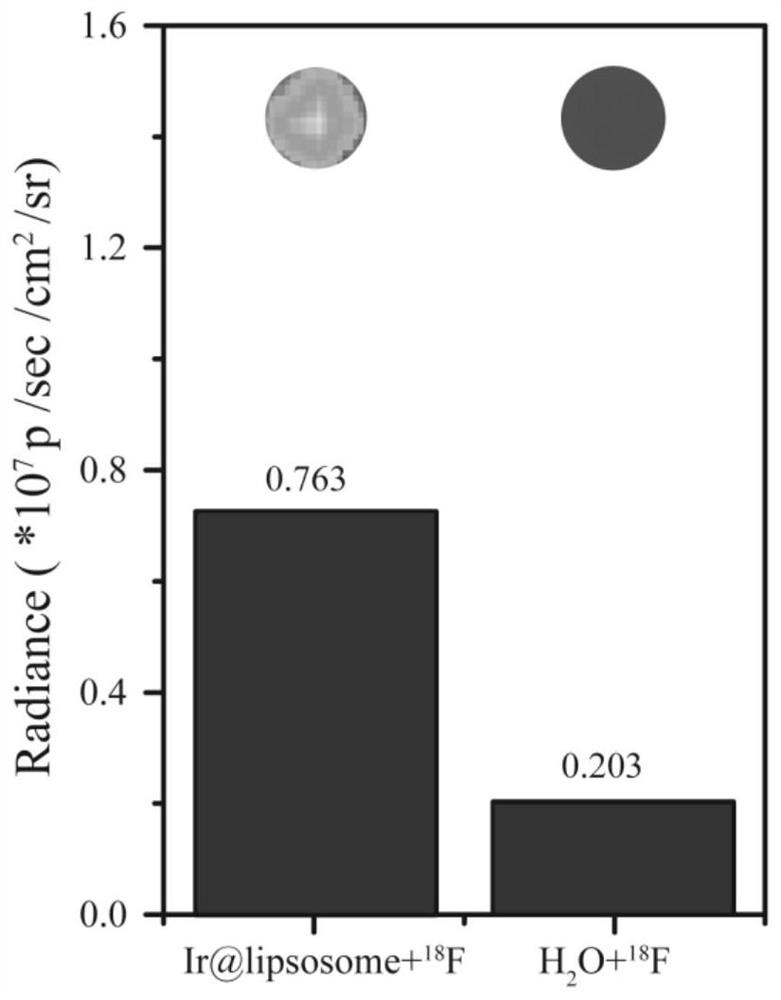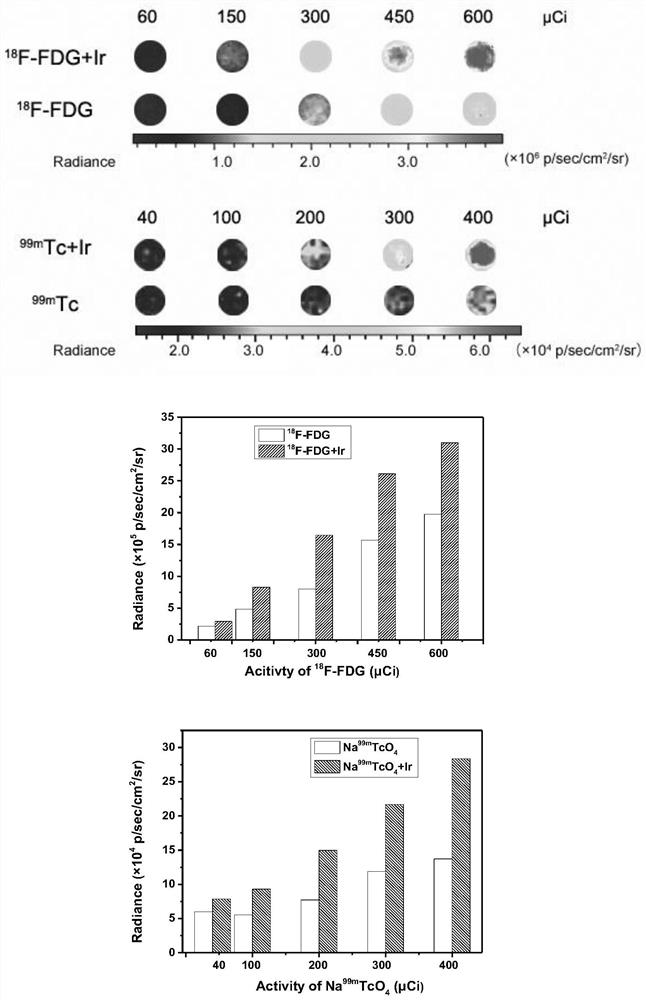Application of a metal iridium complex nanoparticle in nuclide-excited phosphorescence imaging
A complex, metal iridium technology, applied in the direction of luminescent materials, indium organic compounds, platinum group organic compounds, etc., can solve the problems of inability to penetrate deep tissue, high energy, short wavelength, etc., to improve biocompatibility and optical sensitivity. High, good photostability
- Summary
- Abstract
- Description
- Claims
- Application Information
AI Technical Summary
Problems solved by technology
Method used
Image
Examples
Embodiment 1
[0030] 1. Preparation of metal iridium complex nanoparticles: dipalmitoyl phosphatidylcholine (DPPC), cholesterol, DSPE-PEG 2000 , the iridium complex whose structural formula is formula (I) is dissolved in chloroform according to the molar ratio of 6:2:0.5:0.5, and the solvent is removed by rotary evaporation at 30 to 40 °C after mixing evenly; 10 mL of water is then added to carry out hydration reaction, stirring at 45 °C The reaction was carried out for 0.5 hours. The cell crusher was sonicated for 10 min, and the power was 35%. After 0.22 μm filter membrane, dialysis in secondary water for 24 hours, iridium complex nanoparticles were formed.
[0031] 2. Fluorodeoxyglucose ( 18 F-FDG) was provided by the Department of Nuclear Medicine, Affiliated Cancer Hospital of Fudan University, at 100 μCi, the emissive excited phosphorescence of 60 μg / mL Ir-(I) nanoparticles was 18 F-FDG's Cherenkov luminous 3.8 times. For details, see figure 1 .
Embodiment 2
[0033] 18 The maximum wavelength of phosphorescence of F-FDG at 100 μCi with 60 μg / mL Ir-(I) nanoparticles (using the iridium complex nanoparticles prepared in Example 1) is located at 620 nm. For details, see figure 2 .
Embodiment 3
[0035] 1. Preparation of metal iridium (Ⅱ) complex nanoparticles: dipalmitoyl phosphatidyl choline (DPPC), cholesterol, DSPE-PEG 2000, the iridium complex whose structural formula is formula (II) is dissolved in chloroform according to the molar ratio of 6:2:0.5:0.5, and the solvent is removed by rotary evaporation at 30 to 40 °C after mixing evenly; then 10 mL of water is added for hydration reaction, and stirring at 45 °C The reaction was carried out for 0.5 hours. The cell crusher was sonicated for 10 min, and the power was 35%. After 0.22 μm filter membrane, dialysis in secondary water for 24 hours, iridium complex nanoparticles were formed.
[0036] 2. Take 100μL, 100μg / mL of iridium complex nanoparticles of formula (II), add 60, 150, 300, 450, 600μCi 18 The radioactive excitation phosphorescence intensity of F-FDG is the same dose, respectively 18 The Cherenkov luminescence of F-FDG is 1.3, 1.7, 2.1, 1.7, 1.6 times. Specifically as image 3 shown.
[0037] Figure...
PUM
| Property | Measurement | Unit |
|---|---|---|
| water activity | aaaaa | aaaaa |
| concentration | aaaaa | aaaaa |
| concentration | aaaaa | aaaaa |
Abstract
Description
Claims
Application Information
 Login to View More
Login to View More - R&D
- Intellectual Property
- Life Sciences
- Materials
- Tech Scout
- Unparalleled Data Quality
- Higher Quality Content
- 60% Fewer Hallucinations
Browse by: Latest US Patents, China's latest patents, Technical Efficacy Thesaurus, Application Domain, Technology Topic, Popular Technical Reports.
© 2025 PatSnap. All rights reserved.Legal|Privacy policy|Modern Slavery Act Transparency Statement|Sitemap|About US| Contact US: help@patsnap.com



